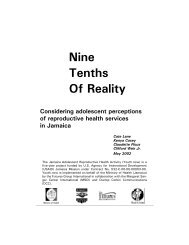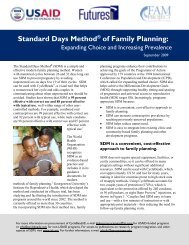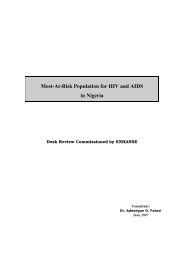- Page 1 and 2:
Health Policy IssuesandHealth Progr
- Page 3 and 4:
ContentsContentsPrefaceList of Part
- Page 6 and 7:
I would also like to thank our tech
- Page 8 and 9:
List of ParticipantsIndu Kumar Pand
- Page 10 and 11:
List of ParticipantsMohmed ShaukatD
- Page 12 and 13:
List of ParticipantsR K PurohitAddi
- Page 14 and 15:
GlossaryGlossaryAbbreviationsAIIMSA
- Page 16 and 17:
GlossaryLHVLILMISMAPMCMCHMDRTBMDTM&
- Page 18 and 19:
GlossaryTHRTRCTRIPsTTTUUDCUIPUPUTVC
- Page 20 and 21:
Inaugural Sessionwould be the first
- Page 22 and 23:
Inaugural SessionOnly 18% of the pr
- Page 24 and 25:
Inaugural SessionMadhukar Gupta, Ch
- Page 26 and 27:
Inaugural Sessionrotational basis f
- Page 28 and 29:
Inaugural Sessiontell you more abou
- Page 30 and 31:
Public Health Issues, Priorities, a
- Page 32 and 33:
Public Health Issues, Priorities, a
- Page 34 and 35:
Public Health Issues, Priorities, a
- Page 36 and 37:
Public Health Issues, Priorities, a
- Page 38 and 39:
National Health Programmes: An Over
- Page 40 and 41:
National Health Programmes: An Over
- Page 42 and 43:
National Health Programmes: An Over
- Page 44 and 45:
National Health Programmes: An Over
- Page 46 and 47:
National Health Programmes: An Over
- Page 48 and 49:
National Health Programmes: An Over
- Page 50 and 51:
National Health Programmes: An Over
- Page 52 and 53:
National Health Programmes: An Over
- Page 54 and 55:
National Health Programmes: An Over
- Page 56 and 57:
Implementation of National Health P
- Page 58 and 59:
Implementation of National Health P
- Page 60 and 61:
Implementation of National Health P
- Page 62 and 63:
Implementation of National Health P
- Page 64 and 65:
Implementation of National Health P
- Page 66 and 67:
Use of Epidemiological Surveillance
- Page 68 and 69:
Use of Epidemiological Surveillance
- Page 70 and 71:
Use of Epidemiological Surveillance
- Page 72 and 73:
Designing a Surveillance SystemFurt
- Page 74 and 75:
Designing a Surveillance Systemsurv
- Page 76 and 77:
National Health Programme in Uttara
- Page 78 and 79:
National Health Programme in Uttara
- Page 80 and 81:
National Health Programme in Uttara
- Page 82 and 83:
National Health Programme in Uttara
- Page 84 and 85:
National Health Programme in Uttara
- Page 86 and 87:
National Health Programme in Uttara
- Page 88 and 89:
National Health Programme in Uttara
- Page 90 and 91:
National Health Programme in Uttara
- Page 92 and 93:
National Health Programme in Uttara
- Page 94 and 95:
IEC Strategies for Health in IndiaS
- Page 96 and 97:
IEC Strategies for Health in Indial
- Page 98 and 99:
IEC Strategies for Health in IndiaS
- Page 100 and 101:
IEC Strategies for Health in IndiaA
- Page 102 and 103:
IEC for Health Programmes in Uttara
- Page 104 and 105:
IEC for Health Programmes in Uttara
- Page 106 and 107:
IEC for Health Programmes in Uttara
- Page 108 and 109:
IEC for Health Programmes in Uttara
- Page 110 and 111:
IEC for Health Programmes in Uttara
- Page 112 and 113:
Session 3Private and Public SectorP
- Page 114 and 115:
Public-Private Interaction in Healt
- Page 116 and 117:
Public-Private Interaction in Healt
- Page 118 and 119:
Public-Private Interaction in Healt
- Page 120 and 121:
Public-Private Interaction in Healt
- Page 122 and 123:
Public-Private Interaction in Healt
- Page 124 and 125:
Cost Recovery Measures in Governmen
- Page 126 and 127:
Cost Recovery Measures in Governmen
- Page 128 and 129:
Cost Recovery Measures in Governmen
- Page 130 and 131:
Arogya Raksha: Health Insurance Sch
- Page 132 and 133:
Arogya Raksha: Health Insurance Sch
- Page 134 and 135:
Arogya Raksha: Health Insurance Sch
- Page 136 and 137:
Arogya Raksha: Health Insurance Sch
- Page 138 and 139:
Arogya Raksha: Health Insurance Sch
- Page 140 and 141:
Arogya Raksha: Health Insurance Sch
- Page 142 and 143: Session 1Session 4Health Financing
- Page 144 and 145: Health Financing in India: Some Iss
- Page 146 and 147: Health Financing in India: Some Iss
- Page 148 and 149: Health Financing in India: Some Iss
- Page 150 and 151: Health Financing in India: Some Iss
- Page 152 and 153: Health Financing in India: Some Iss
- Page 154 and 155: Household Health Care Costs in Indi
- Page 156 and 157: Household Health Care Costs in Indi
- Page 158 and 159: Household Health Care Costs in Indi
- Page 160 and 161: Session 1Session 4Access to Health
- Page 162 and 163: Access to Health Services in Uttara
- Page 164 and 165: Access to Health Services in Uttara
- Page 166 and 167: Access to Health Services in Uttara
- Page 168 and 169: Access to Health Services in Uttara
- Page 170 and 171: Session 5STI/RTI, AIDS, and TB Cont
- Page 172 and 173: Quality of RTI/STI Case Management
- Page 174 and 175: Quality of RTI/STI Case Management
- Page 176 and 177: Quality of RTI/STI Case Management
- Page 178 and 179: Quality of RTI/STI Case Management
- Page 180 and 181: Quality of RTI/STI Case Management
- Page 182 and 183: HIV/AIDS: International Perspective
- Page 184 and 185: HIV/AIDS: International Perspective
- Page 186 and 187: HIV/AIDS: International Perspective
- Page 188 and 189: HIV/AIDS in India and UttaranchalSe
- Page 190 and 191: HIV/AIDS in India and UttaranchalFi
- Page 194 and 195: HIV/AIDS in India and UttaranchalFi
- Page 196 and 197: HIV/AIDS in India and UttaranchalFi
- Page 198 and 199: Tuberculosis Control Efforts in Ind
- Page 200 and 201: Tuberculosis Control Efforts in Ind
- Page 202 and 203: Tuberculosis Control Efforts in Ind
- Page 204 and 205: Tuberculosis Control Efforts in Ind
- Page 206 and 207: Tuberculosis Control Efforts in Ind
- Page 208 and 209: Session 6Other Health IssuesChairpe
- Page 210 and 211: Care of the ElderlySocial care is u
- Page 212 and 213: Care of the ElderlyEach group has d
- Page 214 and 215: Hospital Waste ManagementSession 6H
- Page 216 and 217: Hospital Waste ManagementA hospital
- Page 218 and 219: Hospital Waste Managementbe without
- Page 220 and 221: Hospital Waste ManagementTreatment
- Page 222 and 223: Hospital Waste Management4. Tempera
- Page 224 and 225: Hospital Waste ManagementTable 6. U
- Page 226 and 227: Streamlining the Drug Procurement a
- Page 228 and 229: Streamlining the Drug Procurement a
- Page 230 and 231: Streamlining the Drug Procurement a
- Page 232 and 233: Streamlining the Drug Procurement a
- Page 234 and 235: Streamlining the Drug Procurement a
- Page 236 and 237: Streamlining the Drug Procurement a
- Page 238 and 239: Streamlining the Drug Procurement a
- Page 240 and 241: Sanitation and Public Health Issues
- Page 242 and 243:
Sanitation and Public Health Issues
- Page 244 and 245:
Sanitation and Public Health Issues
- Page 246 and 247:
Ayurveda and Unani Department and t
- Page 248 and 249:
Ayurveda and Unani Department and t
- Page 250 and 251:
Ayurveda and Unani Department and t
- Page 252 and 253:
Specific Health Policy and Programm
- Page 254 and 255:
Specific Health Policy and Programm
- Page 256 and 257:
Specific Health Policy and Programm







